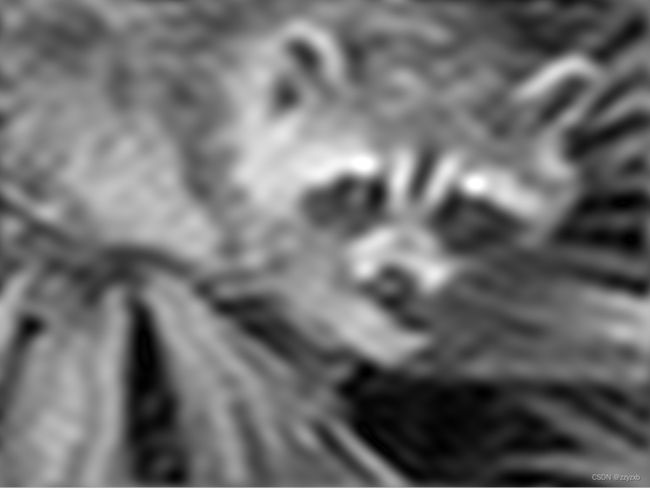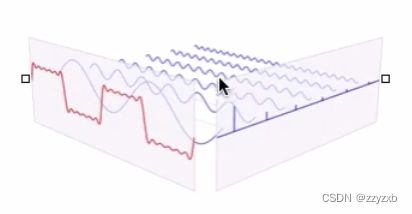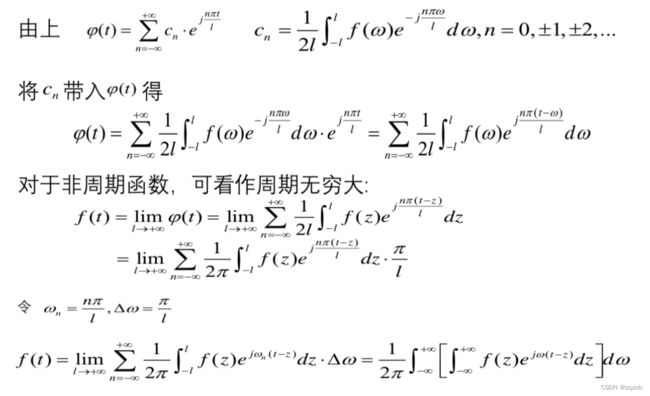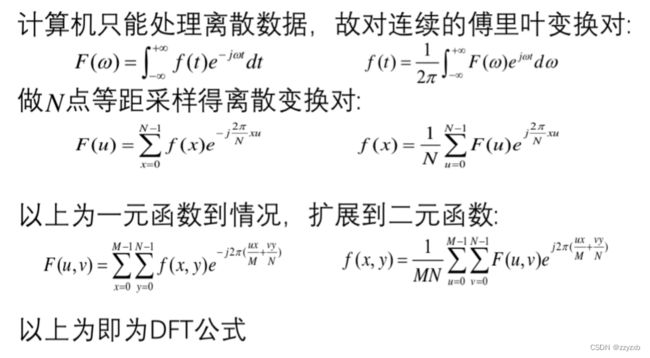03.fourier transform(傅立叶变换)
一:演示
原图
傅里叶变换
原本四个角比较亮(低频),经过四个角平移到中心,中心会比较亮
中心亮的是低频;
四周暗的是高频;
将图像四周置0(暗的区域)后,傅里叶反变换图像:
将图像中心置0(亮的区域)后,傅里叶反变换图像:
二:什么是频域?
红色图像:时域图像;
蓝色图像:频域图像;
三:傅里叶变换的由来
三:傅里叶变换算法(DFT / FFT)
四:源码
fft2d.py
# -*- coding: utf-8 -*-
import numpy as np
import matplotlib.pyplot as plt
def rawFFT(Img, Wr, axis):
if Img.shape[axis] == 2:
pic = np.zeros(Img.shape, dtype=complex)
if axis == 1:
pic[:, 0] = Img[:, 0] + Img[:, 1] * Wr[:, 0]
pic[:, 1] = Img[:, 0] - Img[:, 1] * Wr[:, 0]
elif axis == 0:
pic[0, :] = Img[0, :] + Img[1, :] * Wr[0, :]
pic[1, :] = Img[0, :] - Img[1, :] * Wr[0, :]
return pic
else:
pic = np.empty(Img.shape, dtype=complex)
if axis == 1:
A = rawFFT(Img[:, ::2], Wr[:, ::2], axis)
B = rawFFT(Img[:, 1::2], Wr[:, ::2], axis)
pic[:, 0:Img.shape[1] // 2] = A + Wr * B
pic[:, Img.shape[1] // 2:Img.shape[1]] = A - Wr * B
elif axis == 0:
A = rawFFT(Img[::2, :], Wr[::2, :], axis)
B = rawFFT(Img[1::2, :], Wr[::2, :], axis)
pic[0:Img.shape[0] // 2, :] = A + Wr * B
pic[Img.shape[0] // 2:Img.shape[0], :] = A - Wr * B
return pic
def FFT_1d(Img, axis):
Wr = np.zeros(Img.shape, dtype=complex)
if axis == 0:
Wr = np.zeros((Img.shape[0] // 2, Img.shape[1]), dtype=complex)
temp = np.array([
np.cos(2 * np.pi * i / Img.shape[0]) - 1j * np.sin(2 * np.pi * i / Img.shape[0]) for i in
range(Img.shape[0] // 2)])
for i in range(Wr.shape[1]):
Wr[:, i] = temp
elif axis == 1:
Wr = np.zeros((Img.shape[0], Img.shape[1] // 2), dtype=complex)
temp = np.array([
np.cos(2 * np.pi * i / Img.shape[1]) - 1j * np.sin(2 * np.pi * i / Img.shape[1]) for i in
range(Img.shape[1] // 2)])
for i in range(Wr.shape[0]):
Wr[i, :] = temp
return rawFFT(Img, Wr, axis)
def iFFT_1d(Img, axis):
Wr = np.zeros(Img.shape, dtype=complex)
if axis == 0:
Wr = np.zeros((Img.shape[0] // 2, Img.shape[1]), dtype=complex)
temp = np.array([
np.cos(2 * np.pi * i / Img.shape[0]) + 1j * np.sin(2 * np.pi * i / Img.shape[0]) for i in
range(Img.shape[0] // 2)])
for i in range(Wr.shape[1]):
Wr[:, i] = temp
elif axis == 1:
Wr = np.zeros((Img.shape[0], Img.shape[1] // 2), dtype=complex)
temp = np.array([
np.cos(2 * np.pi * i / Img.shape[1]) + 1j * np.sin(2 * np.pi * i / Img.shape[1]) for i in
range(Img.shape[1] // 2)])
for i in range(Wr.shape[0]):
Wr[i, :] = temp
return rawFFT(Img, Wr, axis) * (1.0 / Img.shape[axis])
def FFT_2d(Img):
'''
only for gray scale 2d-img. otherwise return 0 img with the same size of Img
:param Img: img to be fourior transform
:return: img been transformed
'''
imgsize = Img.shape
pic = np.zeros(imgsize, dtype=complex)
if len(imgsize) == 2:
N = 2
while N < imgsize[0]:
N = N << 1
num1 = N - imgsize[0]
N = 2
while N < imgsize[1]:
N = N << 1
num2 = N - imgsize[1]
pic = FFT_1d(np.pad(Img, ((num1 // 2, num1 - num1 // 2), (0, 0)), 'edge'), 0)[
num1 // 2:num1 // 2 + imgsize[0], :]
pic = FFT_1d(np.pad(pic, ((0, 0), (num2 // 2, num2 - num2 // 2)), 'edge'), 1)[:,
num2 // 2:num2 // 2 + imgsize[1]]
return pic
def iFFT_2d(Img):
'''
only for gray scale 2d-img. otherwise return 0 img with the same size of Img
:param Img: img to be fourior transform
:return: img been transformed
'''
imgsize = Img.shape
pic = np.zeros(imgsize, dtype=complex)
if len(imgsize) == 2:
N = 2
while N < imgsize[0]:
N = N << 1
num1 = N - imgsize[0]
N = 2
while N < imgsize[1]:
N = N << 1
num2 = N - imgsize[1]
pic = iFFT_1d(np.pad(Img, ((num1 // 2, num1 - num1 // 2), (0, 0)), 'edge'), 0)[num1 // 2:num1 // 2 + imgsize[0],
:] # ,constant_values=(255,255)
pic = iFFT_1d(np.pad(pic, ((0, 0), (num2 // 2, num2 - num2 // 2)), 'edge'), 1)[:,
num2 // 2:num2 // 2 + imgsize[1]] # ,constant_values=(255,255)
return pic
if __name__ == "__main__":
img = plt.imread('./img/1.jpg')
img = img.mean(2) # gray
plt.imshow(img.astype(np.uint8), cmap='gray')
plt.axis('off')
plt.show()
F1 = np.fft.fft2(img[:256, :256])
F2 = FFT_2d(img[:256, :256])
print((abs(F1 - F2) < 0.0000001).all())
F1 = np.fft.ifft2(F1)
F2 = iFFT_2d(F2)
print((abs(F1 - F2) < 0.0000001).all())
F2 = np.abs(F2)
F2[F2 > 255] = 255
plt.imshow(F2.astype(np.uint8), cmap='gray')
plt.axis('off')
plt.show()
F1 = np.abs(F1)
F1[F1 > 255] = 255
plt.imshow(F1.astype(np.uint8), cmap='gray')
plt.axis('off')
plt.show()
Presentation.py
import matplotlib.pyplot as plt
import numpy as np
if __name__ == '__main__':
img = plt.imread('./img/raccoon.jpg')
plt.imshow(img, cmap=plt.cm.gray)
plt.axis('off')
plt.show()
img = img.mean(axis=-1)
# plt.imsave('gray_raccoon.jpg', np.dstack((img.astype(np.uint8), img.astype(np.uint8), img.astype(np.uint8))))
img = np.fft.fft2(img)
img = np.fft.fftshift(img)
fourier = np.abs(img)
magnitude_spectrum = np.log(fourier)
plt.imshow(magnitude_spectrum.astype(np.uint8), cmap=plt.cm.gray)
plt.axis('off')
plt.show() # image after fourier transform
# plt.imsave('fourier_raccoon.jpg', 14*np.dstack((magnitude_spectrum.astype(np.uint8),magnitude_spectrum.astype(np.uint8),magnitude_spectrum.astype(np.uint8))))
x, y = img.shape
lowF = np.zeros((x, y))
lowF = lowF.astype(np.complex128)
window_shape = (20, 20)
lowF[int(x / 2) - window_shape[0]:int(x / 2) + window_shape[0],
int(y / 2) - window_shape[1]:int(y / 2) + window_shape[1]] = \
img[int(x / 2) - window_shape[0]:int(x / 2) + window_shape[0],
int(y / 2) - window_shape[1]:int(y / 2) + window_shape[1]]
lowF_im = np.fft.ifft2(lowF)
lowF_im = np.abs(lowF_im)
lowF_im[lowF_im > 255] = 255
plt.imshow(lowF_im.astype(np.uint8), cmap='gray')
plt.axis('off')
plt.show()
# plt.imsave('LowF_raccoon.jpg', np.dstack((lowF_im.astype(np.uint8), lowF_im.astype(np.uint8), lowF_im.astype(np.uint8))))
highF = np.zeros((x, y))
highF = highF.astype(np.complex128)
window_shape = (370, 370)
highF[0:window_shape[0], :] = img[0:window_shape[0], :]
highF[x - window_shape[0]:x, :] = img[x - window_shape[0]:x, :]
highF[:, 0:window_shape[1]] = img[:, 0:window_shape[1]]
highF[:, y - window_shape[1]:y] = img[:, y - window_shape[1]:y]
highF_im = np.fft.ifft2(highF)
highF_im = np.abs(highF_im)
highF_im[highF_im > 255] = 255
plt.imshow(highF_im.astype(np.uint8), cmap='gray')
plt.axis('off')
plt.show()
# plt.imsave('HighF_raccoon.jpg', np.dstack((highF_im.astype(np.uint8), highF_im.astype(np.uint8), highF_im.astype(np.uint8))))
LiveFourierTransform.py
import numpy as np
import time
import cv2
def LiveFFT(rows, columns, numShots=1e5, nContrIms=30):
imMin = .004 # minimum allowed value of any pixel of the captured image
contrast = np.concatenate((
np.zeros((10, 1)), np.ones((10, 1))), axis=1) # internal use.
window_name = 'Livefft by lixin'
vc = cv2.VideoCapture(0) # camera device
cv2.namedWindow(window_name, 0) # 0 makes it work a bit better
cv2.resizeWindow(window_name, 1024, 768) # this doesn't keep
rval, frame = vc.read()
# we need to wait a bit before we get decent images
print("warming up camera... (.1s)")
time.sleep(.1)
rval = vc.grab()
rval, frame = vc.retrieve()
# determine if we are not asking too much
frameShape = np.shape(frame)
if rows > frameShape[1]:
rows = frameShape[1]
if columns > frameShape[0]:
columns = frameShape[0]
# calculate crop
vCrop = np.array([np.ceil(frameShape[0] / 2. - columns / 2.),
np.floor(frameShape[0] / 2. + columns / 2.)], dtype=int)
hCrop = np.array([np.ceil(frameShape[1] / 2. - rows / 2.),
np.floor(frameShape[1] / 2. + rows / 2.)], dtype=int)
# start image cleanup with something like this:
# for a running contrast of nContrIms frames
contrast = np.concatenate((
np.zeros((nContrIms, 1)),
np.ones((nContrIms, 1))),
axis=1)
Nr = 0
# main loop
while Nr <= numShots:
a = time.time()
Nr += 1
contrast = work_func(vCrop, hCrop, vc, imMin, window_name, contrast)
print('framerate = {} fps \r'.format(1. / (time.time() - a)))
# stop camera
vc.release()
def work_func(vCrop, hCrop, vc, imMin, figid, contrast):
# read image
rval = vc.grab()
rval, im = vc.retrieve()
im = np.array(im, dtype=float)
# crop image
im = im[vCrop[0]: vCrop[1], hCrop[0]: hCrop[1], :]
# pyramid downscaling
# im = cv2.pyrDown(im)
# reduce dimensionality
im = np.mean(im, axis=2, dtype=float)
# make sure we have no zeros
im = (im - im.min()) / (im.max() - im.min())
im = np.maximum(im, imMin)
Intensity = np.abs(np.fft.fftshift(np.fft.fft2(im))) ** 2
Intensity += imMin
# kill the center lines for higher dynamic range
# by copying the next row/column
# h, w = np.shape(Intensity)
# Intensity[(h / 2 - 1):(h / 2 + 1), :] = Intensity[(h / 2 + 1):(h / 2 + 3), :]
# Intensity[:, (w / 2 - 1):(w / 2 + 1)] = Intensity[:, (w / 2 + 1):(w / 2 + 3)]
# running average of contrast
##circshift contrast matrix up
contrast = contrast[np.arange(1, np.size(contrast, 0) + 1) % np.size(contrast, 0), :]
##replace bottom values with new values for minimum and maximum
contrast[-1, :] = [np.min(Intensity), np.max(Intensity)]
maxContrast = 1
minContrast = 7 # to be modify
# openCV draw
vmin = np.log(contrast[:, 0].mean()) + minContrast
vmax = np.log(contrast[:, 1].mean()) - maxContrast
Intensity = (np.log(Intensity + imMin) - vmin) / (vmax - vmin)
Intensity = Intensity.clip(0., 1.)
# Intensity = (Intensity - Intensity.min()) / (Intensity.max() - Intensity.min())
time.sleep(.01)
cv2.imshow(figid, np.concatenate((im, Intensity), axis=1))
cv2.waitKey(1)
return contrast
if __name__ == '__main__':
LiveFFT(400, 400)
摘录:会飞的吴克笔记
b站有视频!














